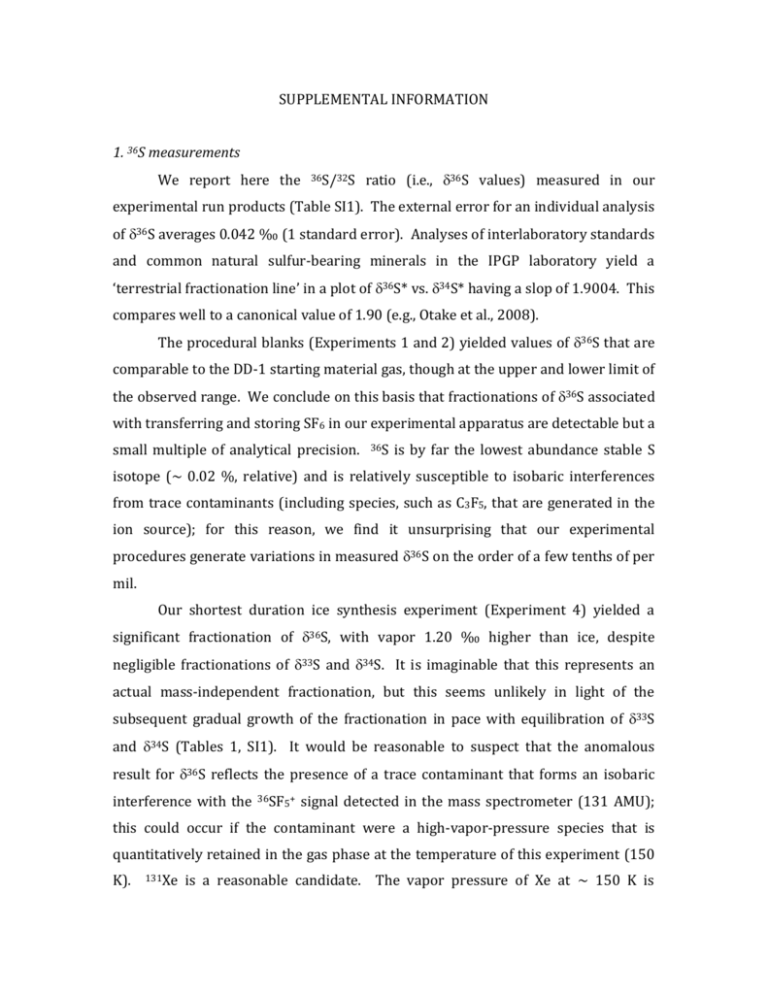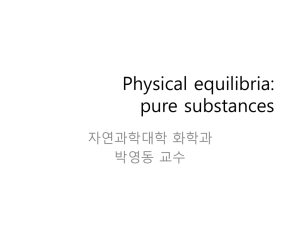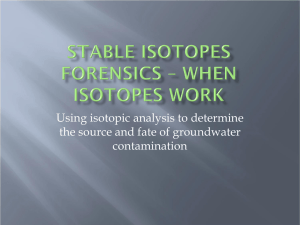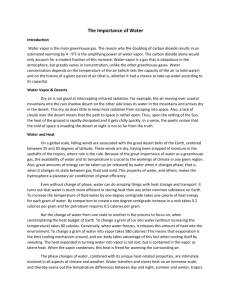Non-canonical mass laws in equilibrium isotopic fractionations
advertisement

SUPPLEMENTAL INFORMATION 1. 36S measurements We report here the 36S/32S ratio (i.e., 36S values) measured in our experimental run products (Table SI1). The external error for an individual analysis of 36S averages 0.042 ‰ (1 standard error). Analyses of interlaboratory standards and common natural sulfur-bearing minerals in the IPGP laboratory yield a ‘terrestrial fractionation line’ in a plot of 36S* vs. 34S* having a slop of 1.9004. This compares well to a canonical value of 1.90 (e.g., Otake et al., 2008). The procedural blanks (Experiments 1 and 2) yielded values of 36S that are comparable to the DD-1 starting material gas, though at the upper and lower limit of the observed range. We conclude on this basis that fractionations of 36S associated with transferring and storing SF6 in our experimental apparatus are detectable but a small multiple of analytical precision. 36S is by far the lowest abundance stable S isotope (~ 0.02 %, relative) and is relatively susceptible to isobaric interferences from trace contaminants (including species, such as C3F5, that are generated in the ion source); for this reason, we find it unsurprising that our experimental procedures generate variations in measured 36S on the order of a few tenths of per mil. Our shortest duration ice synthesis experiment (Experiment 4) yielded a significant fractionation of 36S, with vapor 1.20 ‰ higher than ice, despite negligible fractionations of 33S and 34S. It is imaginable that this represents an actual mass-independent fractionation, but this seems unlikely in light of the subsequent gradual growth of the fractionation in pace with equilibration of 33S and 34S (Tables 1, SI1). It would be reasonable to suspect that the anomalous result for 36S reflects the presence of a trace contaminant that forms an isobaric interference with the 36SF5+ signal detected in the mass spectrometer (131 AMU); this could occur if the contaminant were a high-vapor-pressure species that is quantitatively retained in the gas phase at the temperature of this experiment (150 K). 131Xe is a reasonable candidate. The vapor pressure of Xe at ~ 150 K is hundreds of millibars, and a contaminant of only 1 ppm in the SF6 vapor fraction would explain this result, so this is a physically plausible scenario (though it is surprising that this species could be retained through freeze/thaw cycles involved in transferring analyte to the mass spectrometer bellows). If so, we should expect that a ~ 1 ‰ apparent enrichment in 36S should be accompanied by enrichments of ~ 0.002 and 0.006 ‰ in 33S and 34S, respectively, based on natural abundances of 128Xe and 129Xe and relative abundances of the S isotopes. These are negligible values relative to our analytical and experimental errors and consistent with the lack of observed fractionation of these isotope ratios during Experiment 4. Alternatively, it is imaginable that our 36S results are compromised by an organic contaminant (or species made in the ion source) that makes an interference at 131 AMU. The weighted average of run products (vapor and condensate) for ice synthesis experiments yielded an average 36SCDT value of -0.288±0.092. This is subtly (~ 0.2 ‰) enriched relative to the starting composition. We think that this difference likely reflects subtle, consistent increases due to trace contaminants in most or all experiments. However, it is also possible that this difference reflects removal of a contaminant from the starting gas due to exposure to cold traps and sorption substrates; i.e., it is possible that the run products are the more accurate results. Nevertheless, we have less confidence in our 36S results than in our results for 33S and 34S. We suggest that a confident study of the 36S systematics associated with subtle fractionations, such as the vapor pressure isotope effect experiments presented here, may have to await the development of a class of gas source isotope ratio mass spectrometers capable of mass resolving 36S-bearing analytes from contaminants while retaining the ~0.1 ‰ precision needed for useful measurements. 2.1. Density-functional and Lattice-dynamics models of the vapor pressure isotope effect of SF6 In this section we present our efforts model the vapor pressure isotope effect of SF6 ice using density function theory and lattice dynamics models. These models failed to quantitatively reproduce our experimental data; we suspect this failure largely stems from the inadequacy of our lattice-dynamics model of the solid phonon spectrum. Nevertheless, this work may provide a helpful starting point for future research on this problem and so we present it in some detail. It is relatively straightforward to estimate the reduced partition function ratio of SF6 vapor using estimates of its fundamental modes of vibration, taken either from spectroscopic measurement or ab initio models, combined with UreyBiegeleisen theory of isotope effects on harmonic molecular vibrations: eqn. SI1 where m and m’ are the masses of two isotopes of interest (e.g., 32S and 33S, respectively), and ’ are the symmetry numbers of the isotopologues of interest (e.g., 32SF6 and 33SF6, respectively), i denotes the vibration frequency i (where i corresponds to 1 of the 15—including degenerate modes—intramolecular vibrational frequencies for SF6, Ui = hi/kbT, h is the Plank constant, kb is the Boltzmann constant and T is temperature; Bigeleisen and Mayer, 1947). Frequencies of vibration for all fundamental modes of all isotopic versions of vapor were calculated by density functional theory (DFT), using a coupled cluster singles and doubles (ccsd) technique with a correlation-consistent polarized double zeta (cc-pVDZ) basis set. The structure and vibrational frequencies were optimized in the gas phase as a single molecule; a separate optimization was performed for each individual isotopologue. Our calculated fundamental mode frequencies for 32SF6 (Table SI2) closely resemble those of previous, generally similar theoretical studies (Computational Chemistry Comparison and Benchmark Database, 2011). The model satisfies the Redlich-Teller spectroscopic theorem; i.e., it is selfconsistent with respect to isotope effects on vibration frequencies. The fundamental modes of vibration predicted by such models (including ours) disagree with JANAF table compilations of spectroscopic data (Chase et al., 1985) by approximately ±5 %, relative (compare Table 2 of the main text with Table SI2). We have adopted calculated vibrational frequencies rather than using spectroscopic constraints on fundamental mode frequencies because of the importance to our study of self-consistent treatments of the frequency shifts of each mode on isotopic substitution. Spectroscopic measurements of fundamental modes for materials with approximately natural isotope abundances reflect frequencies of the abundant species (i.e., 32SF6). Scaling these frequencies to other isotopic species (33SF6 and 34SF6) requires knowledge of the reduced masses of these vibrations and the degree of coupling between fundamental modes. If we treat the reduced mass for each mode of vibration using simple analytical expressions (i.e., of the form, µ = mimj/(mi+mj)) and do not consider coupling between modes (see the note at the end of this section for details), we find frequency shifts on heavy isotope substitution that disagree by a factor of several with spectroscopic observations and DFT-type models, particularly for the 4 mode (McDowell and Krohn, 1986; Boudon et al., 2006; see Table SI3). The DFT model we present better matches those spectroscopic constraints on frequency shifts. We conclude that the modest errors in fundamental vibration frequency resulting from DFT modeling are compensated by their better treatment of the effect of isotopic substitution on the 4 vibration mode. The partition function ratio of vapor was calculated using Equation SI1, above, summing over all 15 fundamental modes modeled for each isotopologue of vapor (Table SI2). At an assumed temperature of 150 K, we found values of 33Q/32Q and 34Q/34Q (i.e., partition function ratios) of 1.187452 and 1.398420, respectively. It is less straightforward to estimate the reduced partition coefficient ratio of ice because its phonon spectrum is complex and incompletely known. We approached this problem by constructing lattice dynamics models of the discrete fundamental vibration modes and their dependence on isotopic substitution, using assumed force constants for the S-F and F-F interactions. Our model for SF6 ice used the GULP model for solids (Gale, 1997). Long-range F-F interactions were treated using a Lennard Jones potential, following the form and constants presented in Dove and Pawley (1983); the energy for the F-F potential, ELJ: where = 0.006302(kJ/mol) and = 2.7692(Å). (The Lenard-Jones potential constants are generally similar among models for low temperature solids and liquids). The energy associated with the bending of the F-S-F bonds (‘Ethree’) is treated using a three-body equation: where = 6.5598 (eV rad-2) and 0 = /2 radians (McDowell et al., 1976; Olivet and Vega, 2007). Finally, the energy of harmonic stretching of the fluorine sulfur interaction (‘Eharmonic’) was modeled with a harmonic potential of the form: 2 where r0 = 1.565 Å and the force constant, k2 = 34.1098 eV/Å2 (McDowell et al., 1976; Dove and Pawley, 1983; Olivet and Vega, 2007). Atomic positions in the lattice were taken from Olivet and Vega, 2007, and the model was solved for a structure having the formula: S3F18. The resulting calculated set of fundamental frequencies is presented in Table SI4, which can be compared with the experimentally measured phonon spectrum in the Table 3 of the main text. Note that our lattice-dynamics model is approximately accurate at the low and high end of the frequency range, but does a poor job in the middle (i.e., the observed fundamental frequencies in the range ~450-650 cm-1 and their place in the phonon spectrum appears to be replaced with a group of frequencies in the range ~250-450 cm-1). The model satisfies the Redlich-Teller spectroscopic theorem, so this model, while poor, appears to at least be self-consistent with respect to isotope effects on vibration frequencies. We explored models in which the force constants for the harmonic and bending mode were varied by ±20 %, relative, or the Lenard-Jones potential was increased over a factor of 2. None of these corrected this striking disagreement. It is unclear whether this reflects an over-simplification of the lattice dynamics model we have used, an error in the force constants we’ve assumed, or some other computational mistake on our part. Regardless, this is the most fundamental failing of our model and we suggest it is the best place for any future effort to begin. We suggest the most useful future steps might be higher-level theoretical treatments of the forms and constants for inter-atomic potentials, perhaps supplemented by new spectroscopic studies of the absorption features of isotopically labeled ice. The partition function ratio of ice was calculated using Equation SI1, above, summing over all 63 fundamental modes calculated for each isotopologue of ice. At an assumed temperature of 150 K, we found values of 33Q/32Q and 34Q/34Q for S3F18 ice of 1.455991 and 2.078778, respectively. Finally, we calculated the fractionation factors (33 and 34) between ice and vapor at 150 K using the formula: ice-vapor = (Q’/Q)1/3ice/(Q’/Q)vapor (note that because the formula of the cell modeled by GULP is S3F18, we have taken the cube root of its partition function; i.e., the correct formulation of the reaction we have modeled is: 1/3S3F18(solid) = SF6(vapor)). The resulting values of 33 and 34 are 0.9545 and 0.9126, respectively. This model results in a reversed vapor pressure isotope effect — i.e., the same direction as that observed in our experiments — but calculated fractionations are about a factor of ~40 greater than observed. It seems likely to us that this disagreement can be traced (at least in part) to our model’s poor description of the phonon spectrum of ice (but might also be due to the over simplifications of harmonic models of vibrational isotope effects; Liu et al., 2010). The alternate models we explored (i.e., varying temperature and the various potentials assumed in our lattice dynamics model) yielded qualitatively similar results. The model discussed above does not meaningfully test the hypothesis discussed in the main text and illustrated in Figure 5, principally because the calculated fractionation is so large that it cannot exhibit the peculiar mass law behavior we expect to occur as one approaches the ‘crossover’ from reversed to normal vapor pressure isotope effects. The most obvious next step to improve this model is a more accurate description of the vibrational energetics of SF6 ice, with the goal of matching its known phonon spectrum to within reasonable errors. 2.2. Notes regarding the simple analytical models of isotope effects on 3 and 4 in vapor The effect of isotopic substitution on the frequency of vibration () of an harmonic oscillator can be calculated as a function of the reduced mass (µ), through the expression: ’/ = (µ/µ’)0.5, where the prime indicates an isotopically substituted compound (i.e., 34SF6). Analytical expressions for the reduced masses of the 3 and 4 modes of vibration in SF6 vapor are: µ3 = (6x31.972x18.998)/(6x18.998 + 31.972) — i.e., motion of 6 S-F bonds; and µ4 = (3x31.972x18.998)/(3x18.998 + 31.972) — motion of 3 S-F bonds. The resulting values of µ3 and µ4 — 24.969 and 20.482, respectively — are similar to the values of 25.61 and 20.18 calculated by the DFT model we present above. However, the DFT model calculates changes in 3 and, particularly, 4 with isotopic substitution that differ markedly from those one would estimate by treating each mode as an independent harmonic oscillator (Table SI2). We suspect this reflects the effects of anharmonicity and/or coupling between modes. The frequency shifts on 34S substitution predicted by our DFT model are similar to those observed by spectroscopy, leading us to use this model in our evaluation of the partition function ratio of SF6 vapor. Supplemental Information References Bigeleisen J and Mayer MG (1947) Calculation of equilibrium constants for isotopic exchange reactions. Journal of Chemical Physics 15, 261–267. Boudon V, Domenech JL, Ramos A, Bermejo D and Willner H (2006) High-resolution stimulated Raman spectroscopy and analysis of the n2, n5 and 2n6 bands of 34SF6. Molecular Physics 104, 2653-2661. Chase, M.W., Jr.; Davies, C.A.; Downey, J.R., Jr.; Frurip, D.J.; McDonald, R.A.; Syverud, A.N., JANAF Thermochemical Tables (Third Edition), J. Phys. Chem. Ref. Data,Suppl. 1, 1985, 14, 1. Computational Chemistry Comparison and Benchmark Database, 2011 Dove MT and and Pawley GS (1983) A molecular-dynamics simulation study of the plastic crystalline phase of sulfur-hexafluoride. Journal of Physics C – Solid State Physics 16, 5969-5983. Gale JD (1997) GULP - a computer program for the symmetry adapted simulation of solids. Journal of the Chemical Society - Faraday Transactions 93, 629-637. Liu Q, Tossel JA and Liu Y (2010) On the proper use of the Bigeleisen-Mayer equation and corrections to it in the calculation of isotopic fractionation equilibrium constants. Geochimica et Cosmochimica Acta 74, 6965-69832010 McDowell RS, Aldridge JP and Holland RF (1976) Vibrational Constants and Force Field of Sulfur Hexafluoride. The Journal of Physical Chemistry 80: 1203-1207. McDowell RS and Krohn BJ (1986) Vibrational levels and anharmonicity in SF 6 — II. Anharmonic and potential constants. Spectrochimica Acta 42A, 371-385. Olivet A and Vega LF (2007) Optimized molecular force field for sulfur hexaflouride simulations. Journal of Chemical Physics 126. Art. No. 144502.








